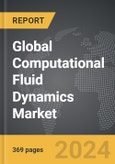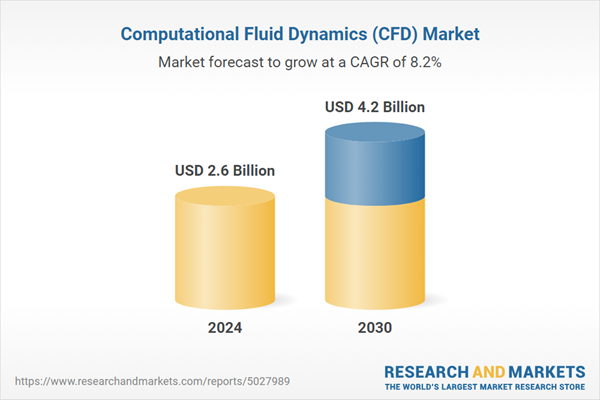The global market for Computational Fluid Dynamics (CFD) was valued at US$2.6 Billion in 2024 and is projected to reach US$4.2 Billion by 2030, growing at a CAGR of 8.2% from 2024 to 2030. This comprehensive report provides an in-depth analysis of market trends, drivers, and forecasts, helping you make informed business decisions. The report includes the most recent global tariff developments and how they impact the Computational Fluid Dynamics (CFD) market.
The field of CFD has seen remarkable advancements driven by improvements in computational power and algorithms. High-performance computing (HPC) and cloud-based solutions have made it possible to perform large-scale simulations with greater accuracy and speed. Innovations in meshing techniques, turbulence modeling, and multiphase flow analysis have expanded the capabilities of CFD, allowing for more detailed and realistic simulations. Furthermore, the integration of CFD with other simulation tools and digital twins is enabling more comprehensive and predictive analyses, facilitating better decision-making and optimization across various engineering disciplines.
The growth in the Computational Fluid Dynamics (CFD) market is driven by several factors. Firstly, the increasing demand for high-fidelity simulations in industries such as aerospace, automotive, and energy is boosting the adoption of CFD. Secondly, advancements in computational power and cloud computing are enhancing the accessibility and efficiency of CFD simulations. Thirdly, the development of advanced modeling techniques and the integration of CFD with digital twins are expanding its applications and improving predictive capabilities. Lastly, the growing emphasis on reducing product development costs and time-to-market is driving the use of CFD to optimize designs and processes early in the development cycle. These factors collectively contribute to the dynamic growth of the CFD market.
Segments: Deployment (Cloud-Based, On-Premise); End-Use (Aerospace & Defense, Automotive, Electrical & Electronics, Other End-Uses).
Geographic Regions/Countries: World; USA; Canada; Japan; China; Europe; France; Germany; Italy; UK; Rest of Europe; Asia-Pacific; Rest of World.
The analysts continuously track trade developments worldwide, drawing insights from leading global economists and over 200 industry and policy institutions, including think tanks, trade organizations, and national economic advisory bodies. This intelligence is integrated into forecasting models to provide timely, data-driven analysis of emerging risks and opportunities.
Global Computational Fluid Dynamics (CFD) Market - Key Trends & Drivers Summarized
Computational Fluid Dynamics (CFD) is a sophisticated simulation technique used to analyze and predict fluid flow, heat transfer, and related phenomena. By solving complex mathematical equations, CFD allows engineers and scientists to visualize and optimize the behavior of fluids within various systems. Applications of CFD span numerous industries, including aerospace, automotive, chemical processing, and energy, where it is used to design more efficient engines, optimize industrial processes, and enhance product performance. CFD simulations provide valuable insights that can significantly reduce the need for physical prototypes and experiments, thereby saving time and costs in the product development cycle.The field of CFD has seen remarkable advancements driven by improvements in computational power and algorithms. High-performance computing (HPC) and cloud-based solutions have made it possible to perform large-scale simulations with greater accuracy and speed. Innovations in meshing techniques, turbulence modeling, and multiphase flow analysis have expanded the capabilities of CFD, allowing for more detailed and realistic simulations. Furthermore, the integration of CFD with other simulation tools and digital twins is enabling more comprehensive and predictive analyses, facilitating better decision-making and optimization across various engineering disciplines.
The growth in the Computational Fluid Dynamics (CFD) market is driven by several factors. Firstly, the increasing demand for high-fidelity simulations in industries such as aerospace, automotive, and energy is boosting the adoption of CFD. Secondly, advancements in computational power and cloud computing are enhancing the accessibility and efficiency of CFD simulations. Thirdly, the development of advanced modeling techniques and the integration of CFD with digital twins are expanding its applications and improving predictive capabilities. Lastly, the growing emphasis on reducing product development costs and time-to-market is driving the use of CFD to optimize designs and processes early in the development cycle. These factors collectively contribute to the dynamic growth of the CFD market.
Report Scope
The report analyzes the Computational Fluid Dynamics (CFD) market, presented in terms of units. The analysis covers the key segments and geographic regions outlined below.Segments: Deployment (Cloud-Based, On-Premise); End-Use (Aerospace & Defense, Automotive, Electrical & Electronics, Other End-Uses).
Geographic Regions/Countries: World; USA; Canada; Japan; China; Europe; France; Germany; Italy; UK; Rest of Europe; Asia-Pacific; Rest of World.
Key Insights:
- Market Growth: Understand the significant growth trajectory of the Cloud-Based segment, which is expected to reach US$2.6 Billion by 2030 with a CAGR of a 9.3%. The On-Premise segment is also set to grow at 6.5% CAGR over the analysis period.
- Regional Analysis: Gain insights into the U.S. market, valued at $758.8 Million in 2024, and China, forecasted to grow at an impressive 8.6% CAGR to reach $439.6 Million by 2030. Discover growth trends in other key regions, including Japan, Canada, Germany, and the Asia-Pacific.
Why You Should Buy This Report:
- Detailed Market Analysis: Access a thorough analysis of the Global Computational Fluid Dynamics (CFD) Market, covering all major geographic regions and market segments.
- Competitive Insights: Get an overview of the competitive landscape, including the market presence of major players across different geographies.
- Future Trends and Drivers: Understand the key trends and drivers shaping the future of the Global Computational Fluid Dynamics (CFD) Market.
- Actionable Insights: Benefit from actionable insights that can help you identify new revenue opportunities and make strategic business decisions.
Key Questions Answered:
- How is the Global Computational Fluid Dynamics (CFD) Market expected to evolve by 2030?
- What are the main drivers and restraints affecting the market?
- Which market segments will grow the most over the forecast period?
- How will market shares for different regions and segments change by 2030?
- Who are the leading players in the market, and what are their prospects?
Report Features:
- Comprehensive Market Data: Independent analysis of annual sales and market forecasts in US$ Million from 2024 to 2030.
- In-Depth Regional Analysis: Detailed insights into key markets, including the U.S., China, Japan, Canada, Europe, Asia-Pacific, Latin America, Middle East, and Africa.
- Company Profiles: Coverage of players such as Autodesk, Inc., Dassault Systemes SE (3DS), Cadence Design Systems, Inc., ANSYS, Inc., Hexagon AB and more.
- Complimentary Updates: Receive free report updates for one year to keep you informed of the latest market developments.
Some of the 96 companies featured in this Computational Fluid Dynamics (CFD) market report include:
- Autodesk, Inc.
- Dassault Systemes SE (3DS)
- Cadence Design Systems, Inc.
- ANSYS, Inc.
- Hexagon AB
- Bentley Systems, Inc.
- ESI Group
- Backoffice Pro
- ESS Engineering Software Steyr
- COMSOL AB
- Cambridge Flow Solutions
- Bell Energy Services UK Limited
- CFD Research Corporation
- CG Thermal, LLC
- Analytical Methods, Inc.
Tariff Impact Analysis: Key Insights for 2025
Global tariff negotiations across 180+ countries are reshaping supply chains, costs, and competitiveness. This report reflects the latest developments as of April 2025 and incorporates forward-looking insights into the market outlook.The analysts continuously track trade developments worldwide, drawing insights from leading global economists and over 200 industry and policy institutions, including think tanks, trade organizations, and national economic advisory bodies. This intelligence is integrated into forecasting models to provide timely, data-driven analysis of emerging risks and opportunities.
What’s Included in This Edition:
- Tariff-adjusted market forecasts by region and segment
- Analysis of cost and supply chain implications by sourcing and trade exposure
- Strategic insights into geographic shifts
Buyers receive a free July 2025 update with:
- Finalized tariff impacts and new trade agreement effects
- Updated projections reflecting global sourcing and cost shifts
- Expanded country-specific coverage across the industry
Table of Contents
I. METHODOLOGYII. EXECUTIVE SUMMARY2. FOCUS ON SELECT PLAYERSIII. MARKET ANALYSISIV. COMPETITION
1. MARKET OVERVIEW
3. MARKET TRENDS & DRIVERS
4. GLOBAL MARKET PERSPECTIVE
UNITED STATES
CANADA
JAPAN
CHINA
EUROPE
FRANCE
GERMANY
ITALY
UNITED KINGDOM
REST OF EUROPE
ASIA-PACIFIC
REST OF WORLD
Companies Mentioned (Partial List)
A selection of companies mentioned in this report includes, but is not limited to:
- Autodesk, Inc.
- Dassault Systemes SE (3DS)
- Cadence Design Systems, Inc.
- ANSYS, Inc.
- Hexagon AB
- Bentley Systems, Inc.
- ESI Group
- Backoffice Pro
- ESS Engineering Software Steyr
- COMSOL AB
- Cambridge Flow Solutions
- Bell Energy Services UK Limited
- CFD Research Corporation
- CG Thermal, LLC
- Analytical Methods, Inc.
Table Information
| Report Attribute | Details |
|---|---|
| No. of Pages | 369 |
| Published | April 2025 |
| Forecast Period | 2024 - 2030 |
| Estimated Market Value ( USD | $ 2.6 Billion |
| Forecasted Market Value ( USD | $ 4.2 Billion |
| Compound Annual Growth Rate | 8.2% |
| Regions Covered | Global |









